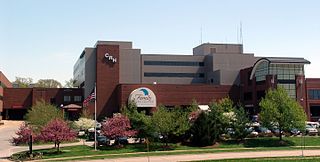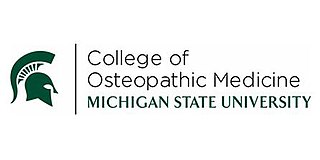
The University of Missouri System is an American state university system providing centralized administration for four universities, a health care system, an extension program, and ten research and technology parks. Nearly 70,000 students are currently enrolled at its four campuses. The health care system operates several hospitals and clinics in central Missouri, while the extension program provides distance learning and other educational initiatives statewide.

The Indiana University School of Medicine (IUSM) is a major multi-campus medical school located in the US state of Indiana. There are nine campuses throughout the state; the principal research, educational, and medical center is located on the Indiana University–Purdue University Indianapolis (IUPUI) campus in Indianapolis. With 1,452 MD students and 203 PhD students in the 2022–23 academic year, IUSM is the largest medical school in the United States. The school offers many joint degree programs including an MD-PhD Medical Scientist Training Program in a partnership with Purdue University's Weldon School of Biomedical Engineering. It is the medical school with the largest number of graduates licensed in the United States per a 2018 Federation of State Medical Boards survey with 11,828 licensed physicians.

Eastern Virginia Medical School (EVMS) is a public medical school in Norfolk, Virginia. Founded by grassroots efforts in the Southeastern part of Virginia known as Hampton Roads, EVMS is not affiliated with an undergraduate institution and coordinates training through multiple medical centers in the Hampton Roads region. EVMS campus includes the 555-bed Sentara Norfolk General Hospital, the region's only tertiary level 1 trauma medical care facility, and the 212-bed Children's Hospital of The King's Daughters, a regional pediatric referral care facility and only stand-alone children's hospital in the state. EVMS is the first institution in the US to have produced a viable fetus through in vitro fertilization. EVMS is most known for its reproductive medicine and simulation/standardized-patient education as well as research in pediatrics, geriatrics, diabetes, and cancer. In addition, EVMS is well known for its leadership in community service and medical missions as evidenced by faculty and alumni responsible for the founding of Operation Smile, Physicians for Peace, Global Brigades, and CONRAD.
The Duke University School of Medicine, commonly known as Duke Med, is the medical school of Duke University. It is located in the Collegiate Gothic-style West Campus of Duke University in Durham, North Carolina. The School of Medicine, along with the Duke University School of Nursing, Duke University Hospital, Duke Regional Hospital, Duke Children's Hospital, Duke Raleigh Hospital, and other affiliated hospitals, clinics, and laboratories, make up the Duke University Health System. Established in 1925 by James B. Duke, the School of Medicine has earned its reputation as an integral part of one of the world's foremost patient care and biomedical research institutions.

The Michigan State University College of Human Medicine (MSUCHM) is an academic division of Michigan State University (MSU) that grants the Doctor of Medicine (MD) degree, emphasizing patient-centered care and a biopsychosocial approach to caring for patients. Required courses at the college reinforce the importance of ethics and professionalism in medicine. In 2013, U.S. News & World Report ranked the college 46th for primary care. The college was also ranked for family medicine and rural medicine. More than 4,000 M.D.s have graduated from the college. Pre-clinical campuses are located on MSU's main campus in East Lansing, Michigan and in downtown Grand Rapids, Michigan, while the clinical rotations are at seven community campuses located throughout Michigan.
Southern Illinois University School of Medicine is a medical school located in Springfield, the capital of the U.S. state of Illinois. It is part of the Southern Illinois University system, which includes a campus in Edwardsville as well as the flagship in Carbondale. The medical school was founded in 1970 and achieved full accreditation in 1972. It was founded to relieve a chronic shortage of physicians in downstate Illinois.
Wake Forest University School of Medicine is the medical school of Wake Forest University, with two campuses located in Winston-Salem, North Carolina and Charlotte, North Carolina, United States. It is affiliated with Atrium Health Wake Forest Baptist, the academic medical center whose clinical arm is Atrium Health Wake Forest Baptist. In 2021, U.S. News & World Report ranked Wake Forest School of Medicine 48th best for research in the nation and 80th best for primary care. The School of Medicine also ranks in the top third of U.S. medical schools in funding from the National Institutes of Health (NIH).

Stamford Hospital, residing on the Bennett Medical Center campus, is a 305-bed, not-for-profit hospital and the central facility for Stamford Health. The hospital is regional healthcare facility for Fairfield and Westchester counties, and is the only hospital in the city of Stamford, Connecticut.
Southeast Hospital is a private, not-for-profit hospital located in Cape Girardeau, Missouri. Southeast Missouri Hospital first opened in 1928 and has grown into a regional medical complex serving over 600,000 people in 22 counties in Southeast Missouri and Southern Illinois. In 2007, the hospital had 269 licensed beds, 11,487 admissions and employed over 2,000 people.

University Hospital is located in Columbia, Missouri. It has the only Level I trauma center and helicopter service in Mid-Missouri, and the only burn intensive care unit in the region. It also has an accredited chest pain center cardiology program and a multidisciplinary digestive disease program. The hospital is affiliated with the University of Missouri and the University of Missouri School of Medicine.

University of Missouri Health Care is an American academic health system located in Columbia, Missouri. It's owned by the University of Missouri System. University of Missouri Health System includes five hospitals: University Hospital, Ellis Fischel Cancer Center, Missouri Orthopedic Institute and University of Missouri Women's and Children's Hospital — all of which are located in Columbia. It's affiliated with Capital Region Medical Center in Jefferson City, Missouri. It also includes more than 60 primary and specialty-care clinics and the University Physicians medical group.

The University of Missouri Women's Hospital, formerly University of Missouri Women's Hospital, is the only hospital in Missouri exclusively dedicated to the health of women. The hospital was formerly home to MU Children's Hospital, and is currently home to MU Women's Center, and the Family Birth Center. The Women's Hospital no longer has a pediatric Emergency Room and inpatient services, having moved to University Hospital. In Fiscal Year 2009, 1,793 babies were born in the Family Birth Center. The hospital has the da Vinci minimally invasive surgical robotic system. It is located in eastern Columbia near the interchange of Interstate 70 and U.S. 63 at 404 North Keene Street.

The Florida State University College of Medicine, located in Tallahassee, Florida, is one of sixteen colleges composing the Florida State University. The college, created in 2000, is an accredited medical school, offering the Doctor of Medicine (M.D.) degree for physicians. The College of Medicine also offers a Ph.D. degree and a Physician Assistant program.

The University of North Carolina School of Medicine is a professional school within the University of North Carolina at Chapel Hill. It offers a Doctor of Medicine degree along with combined Doctor of Medicine / Doctor of Philosophy or Doctor of Medicine / Master of Public Health degrees.

Kansas City University (KCU) is a private medical school with its main campus in Kansas City, Missouri and an additional campus in Joplin, Missouri. Founded in 1916, KCU is one of the original osteopathic medical schools in the United States. It consists of both a College of Osteopathic Medicine and a College of Biosciences. KCU is one of the largest medical schools in the nation by enrollment.
A.T. Still University (ATSU) is a private medical school based in Kirksville, Missouri, with a second campus in Arizona and third campus in Santa Maria, California. It was founded in 1892 by Andrew Taylor Still and was the world's first osteopathic medical school. It is accredited by the Higher Learning Commission. ATSU includes three campuses on 200 acres with seven schools and colleges.

The University of Missouri is a public land-grant research university in Columbia, Missouri. It is Missouri's largest university and the flagship of the four-campus University of Missouri System. MU was founded in 1839 and was the first public university west of the Mississippi River. It has been a member of the Association of American Universities since 1908 and is classified among "R1: Doctoral Universities – Very high research activity". University of Missouri alumni, faculty, and staff include 18 Rhodes Scholars, 19 Truman Scholars, 141 Fulbright Scholars, 7 Governors of Missouri, and 6 members of the U.S. Congress. Two alumni and faculty have been awarded the Nobel Prize: alumnus Frederick Chapman Robbins won the Nobel Prize in Physiology or Medicine in 1954 and George Smith (chemist) was awarded the Nobel Prize in Chemistry in 2018 while affiliated with the university.

The Michigan State University College of Osteopathic Medicine (MSUCOM) is one of the two public medical schools of Michigan State University, a public land-grant research university in East Lansing, Michigan. The college grants the Doctor of Osteopathic Medicine (D.O.) degree, as well as a DO-PhD combined degree for students interested in training as physician-scientists. MSUCOM operates two satellite campuses in Clinton Township and Detroit. The college is accredited by the American Osteopathic Association's Commission on Osteopathic College Accreditation (COCA) and by the Higher Learning Commission.

University at Buffalo School of Medicine and Biomedical Sciences, also known as Jacobs School of Medicine and Biomedical Sciences, is a public medical school in the city of Buffalo, New York at the University at Buffalo. Founded in 1846, it is one of the oldest medical schools in the United States and is the only medical school in Buffalo. It is part of the State University of New York (SUNY) system.
The MU School of Health Professions is the University of Missouri system’s only school of health professions and the state’s only public health program located on a health sciences campus. Its mission is to improve the health and well-being of others.














